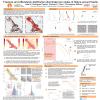Poster #154, Fault and Rupture Mechanics (FARM)
Validate simulated fault displacements from dynamic rupture against the observed in the 1992 Landers earthquake
Poster Image:

Poster Presentation
2020 SCEC Annual Meeting, Poster #154, SCEC Contribution #10485 VIEW PDF
. Advancements in physics-based simulation models make them an attractive approach to address this important problem. Dynamic rupture constructs earthquake rupture evolution and seismic wave propagation under plausible physical conditions. In contrast to kinematic source models, they can be used to quantify fault displacement through physical causative parameters instead of pre-defined descriptions of resultant slip distributions. Dynamic models can also capture off-fault inelastic distributed fault displacements. Once validated against well-documented case histories, the models can be used to predict displacements for scenarios and events we have not yet experienced. We perform the validation against on- and off-fault displacement data from the 1992 Landers M7.1 earthquake. We also perform a sanity-check validation of ground motions against recordings from the event, to ensure that all physics important to modeling have been properly parameterized, which is critical to its use for the forward modeling of new events. We develop an ensemble of spontaneous dynamic rupture models with varying imposed stresses and geometrical fault roughness level, resulting in a suite of 48 simulation datasets. We share results obtained to date and provide insight on the uncertainty of resulting ruptures including their magnitude, length, propagation velocity and displacement distributions. It is physically plausible to predict displacements for future earthquakes of considerable uncertainty (e.g., rupture length, rupture velocity, and fault brach selection).
SHOW MORE
SHOW MORE


































































